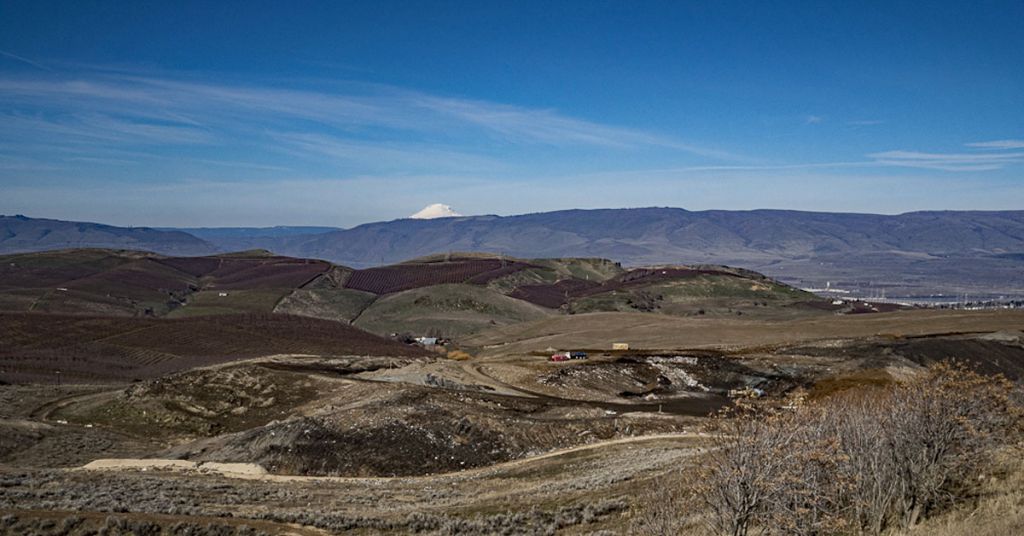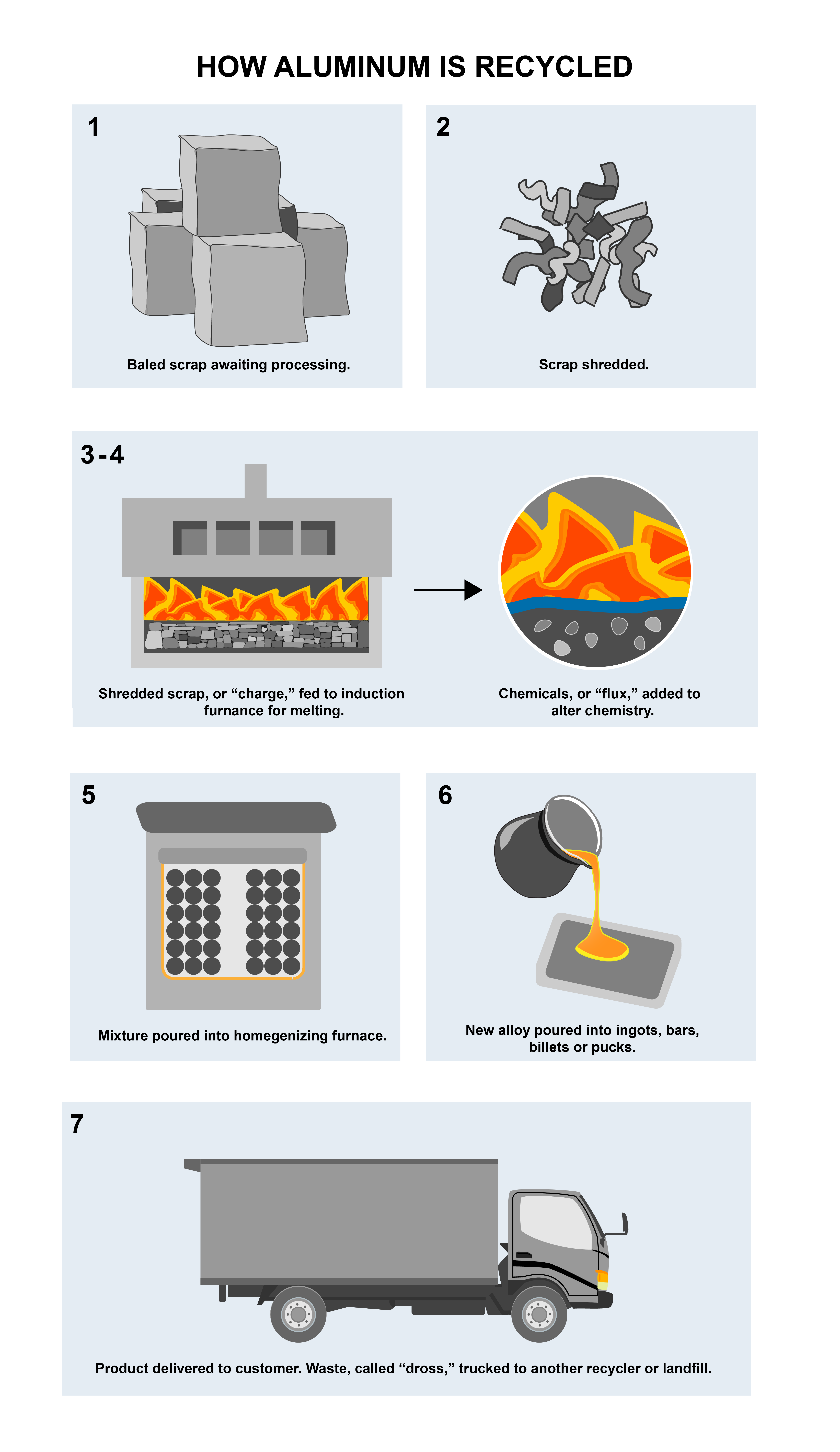The mid-Columbia aluminum industry may be gone but area landfills still store their legacy—at what risk?


Out of the way: With Mt. Adams visible in the distance, the Wasco County Landfill near The Dalles, Oregon, stores some aluminum waste. Photo by Jurgen Hess
By Valerie Brown. March 25, 2021. During the heyday of aluminum production in the Columbia River Basin, which crashed to a halt circa 2000, there were nearly a dozen smelters operating, with two in the mid-Columbia region in Goldendale, Washington, and The Dalles, Oregon. There was also a smelter waste reprocessor at Dallesport Industrial Park on the Washington side of the Columbia River across from The Dalles.
Currently there is one aluminum recycler—Hydro Extrusions—in The Dalles. It’s located on the former smelter property it shares with a Google data center.
Aluminum processing, including recycling, produces waste that can put humans and the environment at risk. For much of the industry’s history, that waste was stored on-site at the smelters.
After the industry collapsed—in part due to spikes in energy costs related to the Enron scandal of 2001-02—most closed smelters were re-labeled as Superfund sites and remediated to keep the worst of their toxic legacies from spreading beyond their boundaries. These sites, including the Goldendale and The Dalles smelters, now must be monitored for the foreseeable future.
Remediation included moving tons of waste. Where it went hasn’t been much of a concern to the public. Surely it was trucked to sites properly designed and licensed to receive such toxic materials, right? Not so much.


Much of the waste was actually taken to municipal solid waste (MSW) landfills within a few miles of The Dalles and Goldendale.
MSWs are regulated under the Resource Conservation and Recovery Act (RCRA) Subtitle D—where household garbage, furniture, plastics and the like go. MSW landfills are not supposed to accept “hazardous” waste—materials that are ignitable, corrosive, reactive and/or toxic—which theoretically go to Subtitle C landfills. These specially designated facilities are subject to more stringent recordkeeping and reporting requirements, permitting and technical standards, and storage, disposal location, construction and operating guidelines.
But regulators have flexibility in how they apply the rules and aluminum waste’s regulatory status is ambiguous. It’s not precisely illegal to store it in MSW landfills, but it still poses fire, explosion and groundwater contamination hazards that have prompted increasing concern from the U.S. Environmental Protection Agency as the aluminum recycling industry expands.
There are two RCRA Subtitle D MSW landfills in the mid-Columbia that store aluminum waste: the Wasco County Landfill (WCL) about four miles southeast of The Dalles and the Roosevelt Regional Landfill 60 miles east on the Washington side of the river.
After the industry collapsed, it took at least another 15 years to complete smelter cleanups and settle legal liability. During this period both the Washington Department of Ecology and the Oregon Department of Environmental Quality worked out ways for these MSW landfills to accept thousands of tons of aluminum waste whose hazards were ambiguous.
Only a relatively small, undeniably hazardous proportion was taken to Chemical Waste Management near Arlington, Oregon, which is an RCRA Subtitle C landfill.
Information scarce
Regulations regarding disposal of aluminum waste are confusing. The federal government and the Oregon DEQ use the term “hazardous,” while Washington uses “dangerous.” Concerns about waste change depending on whether it’s in situ and un-remediated or removed and sequestered from the general environment.
The main concern regarding aluminum waste while it was at the Dallesport facility was the risk it posed to surface and groundwater from cyanide, chromium, nitrates and salts.


But landfills present more complex hazards. Aluminum waste may undergo unanticipated chemical reactions with the myriad trash it encounters in municipal solid waste. Managers are required to monitor not only the leachate—fluids that trickle through the waste and collect at the bottom above the liners of containers—but also the numerous gases that are generated as the waste decomposes both with the help of microorganisms and through inorganic processes.
Currently there is only one aluminum operation in the mid-Columbia region: Hydro Extrusions, the aluminum recycling company in The Dalles. It also produces waste in the form of dross.
Hydro’s waste is trucked from The Dalles to Real Alloy Recycling in Post Falls, Idaho. Details about the disposal of this waste are unavailable. Neither Hydro Extrusions nor Real Alloy Recycling responded to requests for information or comment for this story.
Failure to control the dust from dross being loaded onto trucks for transfer to Real Alloy was one of the violations that triggered the historic $1.3 million fine levied against Hydro Extrusions in 2019 by the Oregon DEQ. The Hydro case remains in litigation with the DEQ.
MORE: Pollution from aluminum still an issue in The Dalles
The total amount of aluminum waste remaining in landfills and on closed smelter sites in the Columbia River Basin is unknown. According to Ecology, by the time remediation actions were complete, about 135,000 tons of material had been removed. Approximately 49,000 tons of that waste is in the WCL.
Per review of available information, in 2009 the WCL accepted about 5,300 tons of waste from the Goldendale smelter as that facility was being demolished. Documents reviewed for this story don’t mention the amount, composition and disposition of the tons of waste sent to the WCL between 1989 and 1991 by the reprocessor Recycled Aluminum Metals Company (RAMCO), which operated at the Dallesport Industrial Park.
What risk?
Everybody is exposed to aluminum—it’s the third most abundant element in the earth’s crust. Sources of aluminum exposure include drinking water, antiperspirants, tea, tobacco smoke and cosmetics.
For most people aluminum comes and goes fairly rapidly, but some of it accumulates in bones and the brain.
Over time, people who work in aluminum processing and residents of neighborhoods near processing sites are likely to be more exposed than the general public to both larger amounts of aluminum and other chemicals used in the industry.
Numerous studies have found cognitive decline among workers exposed to aluminum, including from welding and smelter occupations. Although research is inconclusive, aluminum has also been suggested as a factor in autism spectrum disorder, Parkinson’s disease, multiple sclerosis and amyotrophic lateral sclerosis.


Little information exists regarding the amounts and types of exposure to Hydro’s pollutants experienced by local residents or whether they are suffering from health problems associated with aluminum recycling materials. The relatively small size of The Dalles’ population would make it difficult to obtain statistically significant data for specific neighborhoods. Most available epidemiological data from the Oregon Health Authority does not include data at the city level.
The legacy of aluminum processing in the Columbia River Basin nevertheless extends far beyond the factories themselves and will last lifetimes. Aluminum companies and landfills have not always followed regulations or taken actions protective of human safety and health and ecosystem integrity.
MORE: Aluminum’s legacy continues to hang over the Gorge
State and federal regulatory agencies have often treated waste disposal rules as flexible suggestions, allowing the waste to go to MSW landfills where there is low confidence in its stability—perhaps because it was not actually illegal and was the best available option given logistic and budget limitations.
So far, there have been no major disasters at MSW landfills related to aluminum waste. But the waste still poses hazards ranging from groundwater contamination to landfill fires and explosions.
Based on the historical record, it appears that the relative calm is as much due to luck as it is to wise decision-making and safe handling.
Valerie Brown has covered environmental health for more than two decades, publishing in Environmental Health Perspectives, Scientific American, High Country News and elsewhere.
Infographics by Mackenzie Miller.









